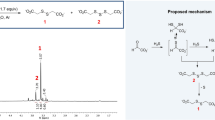Abstract
The biosynthesis of the 3-hydroxyvalerate (3HV) monomer of polyhydroxyalkanoate by Rhodococcus ruber from succinic acid was investigated using nuclear magnetic resonance analysis. Polymer produced from [2,3-13C]- and [1,4-13C]succinate showed that the C-1-C-2 and C-4-C-5 fragments of 3HV were derived from carbons 2 and 3 of succinate, essentially without bond cleavage, and carbon 3 of 3HV was derived from a carboxyl carbon of succinate. Using [1,2-13C]succinate it was demonstrated that the C-1-C-2 bond of succinate was cleaved during polymer biosynthesis. Methylmalonyl-coenzyme A (CoA) mutase activity was detected in cell-free extracts of R. ruber by enzyme assay and HPLC analysis of reaction products. A pathway, involving the known methylmalonyl-CoA pathway for propionate formation in Propionibacteria, followed by the established pathway for PHA biosynthesis from propionyl-CoA and acetyl-CoA, is proposed for the biosynthesis of 3HV from succinate by R. ruber.
Similar content being viewed by others
References
Anderson AJ, Haywood GW, Williams DR, Dawes EA (1990) The production of polyhydroxyalkanoates from unrelated carbon sources. In: Dawes EA (ed) Novel biodegradable microbial polymers. Kluwer, Dordrecht, pp 119–129
Anderson AJ, Williams DR, Taidi B, Dawes EA, Ewing DF (1992) Studies on copolyester synthesis by Rhodococcus ruber and factors influencing the molecular mass of polyhydroxybutyrate accumulated by Methylobacterium extorquens and Alcaligenes eutrophus. FEMS Microbiol Rev 103:93–102
Ballard DGH, Holmes PA, Senior PJ (1987) Formation of polymers of β-hydroxybutyric acid in bacterial cells and a comparison of the morphology of growth with the formation of polyethylene in the solid state. In: Fontanille M, Guyot A (eds) Recent advances in mechanistic and synthetic aspects of polymerization. Reidel (Kluwer) Publishing, Lancaster, UK, pp 293–314
Dawes EA, Senior PJ (1973) The role and regulation of energy reserve polymers in micro-organisms. Adv Microbial Physiol 10:135–266
Denger K, Schink B (1990) New motile anaerobic bacteria growing by succinate decarboxylation to propionate. Arch Microbiol 154:550–555
Doi Y (1990) Microbial Polyesters. VCH, New York
Doi Y, Tamaki A, Kunioka M, Soga K (1987) Biosynthesis of an unusual copolyester (10 mol% 3-hydroxybutyrate and 90 mol% 3-hydroxyvalerate units) in Alcaligenes eutrophus from pentanoic acid. J Chem Soc Commun 1635–1636
Halarnkar PP, Blomquist GJ (1989) Comparative aspects of propionate metabolism. Comp Biochem Physiol 92:227–231
Haywood GW, Anderson AJ, Dawes EA (1989) A survey of the accumulation of novel polyhydroxyalkanoates by bacteria. Biotechnol Lett 11:471–476
Haywood GW, Anderson AJ, Williams DR, Dawes EA, Ewing DF (1991) Accumulation of a poly(hydroxyalkanoate) copolymer containing primarily 3-hydroxyvalerate from simple carbohydrate substrates by Rhodococcus sp. NCIMB 41 126. Int J Biol Macromol 13:83–88
Holmes PA, Wright LF, Collins SH (1985) Beta-hydroxybutyrate polymers. European patent specification 0 052 459
Kim GJ, Yun KY, Bae KS, Rhee YH (1992) Accumulation of copolyesters consisting of 3-hydroxybutyrate and 3-hydroxyvalerate by Alcaligenes sp. SH-69 in batch culture. Biotechnol Lett 14:27–32
Liebergesell M, Hustede E, Timm A, Steinbüchel A, Fuller RC, Lenz RW, Schlegel HG (1991) Formation of poly(3-hydroxyalkanoates) by phototrophic and chemolithotrophic bacteria. Arch Microbiol 155:415–421
Rodriguez-Valera F, Lillo JAG (1990) Halobacteria as producers of poly-β-hydroxyalkanoates. In: Dawes EA (ed) Novel biodegradable microbial polymers. Kluwer, Dordrecht, pp 425–426
Steinbüchel A (1991) Polyhydroxyalkanoic acids. In: Byrom D (ed) Biomaterials. Novel materials from biological sources. Macmillan, Basingstoke, pp 123–213
Steinbüchel A, Pieper U (1992) Production of a copolyester of 3-hydroxybutyric acid and 3-hydroxyvaleric acid from single unrelated carbon sources by a mutant of Alcaligenes eutrophus. Appl Microbiol Biotechnol 37:1–6
Wood HG, Jacobson B, Gerwin BI, Northrop DB (1969) Oxaloacetate transcarboxylase from Propionibacterium. Methods Enzymol 13:215–230
Author information
Authors and Affiliations
Additional information
Correspondence to: A. J. Anderson
Rights and permissions
About this article
Cite this article
Williams, D.R., Anderson, A.J., Dawes, E.A. et al. Production of a co-polyester of 3-hydroxybutyric acid and 3-hydroxyvaleric acid from succinic acid by Rhodococcus ruber: biosynthetic considerations. Appl Microbiol Biotechnol 40, 717–723 (1994). https://doi.org/10.1007/BF00173334
Received:
Revised:
Accepted:
Issue Date:
DOI: https://doi.org/10.1007/BF00173334




